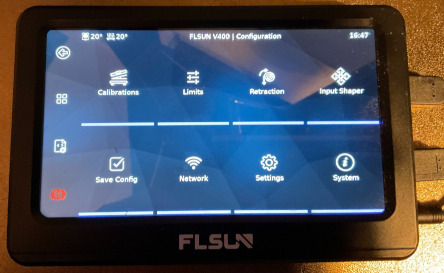3d-Printing with FLSUN V400
Disclaimer: I am reporting here from my own from my hobby and am in no way affiliated with the brands or companies. All materials are self-selected, purchased and I have no relationship with the distributors or manufacturers. In a world full of "influencers" I guess you have to make this clear.
The printer
The FLsun V400 is an solid fast delta 3d printer.

A delta 3D printer is a type of 3D printer that uses a unique kinematic system for its movement. Unlike Cartesian 3D printers, which use three linear rails and a print head that moves along those rails in the X, Y, and Z directions, delta printers use three arms arranged in a triangular configuration. The print head is suspended from these arms and moves by adjusting the length of the arms. The Printer uses a stationary build platform and a moving print head that moves along the axes to create three-dimensional objects by depositing material layer by layer. The a main feature is its relatively large printing capacity.
But the printer was not perfect in its set up and needed some tweaking. It will print out-of-the-box, and the hardware is really solid but the shipped software configuration by FLsun is not good. There is a control unit, the "speeder pad" included with the printer. It runs Ubuntu with a custom version of the control software klipper and user interface mainsail and web api Moonraker. This combination actually makes a good package, but as mentioned, the configuration is not well implemented and FLsun has hidden some parameters and basic functions. Their version of clipper is also poorly maintained and outdated. The good news: You can "easily" switch to the vanilla version of klipper and use your own configuration. There is a active community and really good profiles.
This will improve the printing quality by a lot.

Input Shaper for measuring resonances
Input shaping is a technique used to improve the printing quality and reduce the impact of vibrations and mechanical oscillations during the printing process. These vibrations can arise from the movement of the printer's mechanical components or the rapid changes in direction of the print head. I used a Raspberry Pi Pico in connection with the ADXL345 to measure the vibration of the print head. Klipper has an option determined values to the resonant frequency to take into account and thus improve the printing.
Filament
So far I have printed my prints with PLA. The filament is considered beginner-friendly because it can be printed under comparatively simple conditions. I use recycled materials from 3djake and have done quite well with it so far. PLA can also be recycled comparatively well and is also harmless in terms of vapors and emissions during printing, which is why I prefer this material. However, it is UV sensitive and not very temperature resistant. But it is hard enough for everyday household items.